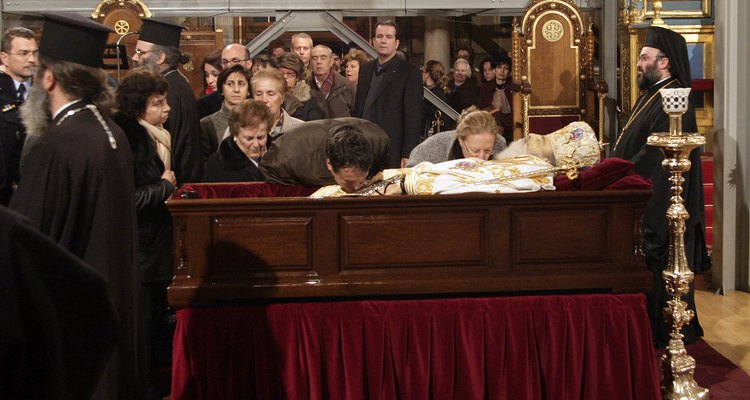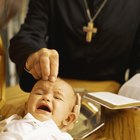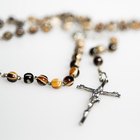
Uriel Sinai/Getty Images News/Getty Images
A Greek Orthodox funeral consists of five stages. There is a wake -- typically the day before the funeral -- a funeral service, a burial and often a funeral luncheon. There are several Greek Orthodox customs which take place within these stages. However, in order to have a Greek Orthodox funeral, the deceased must first be deemed eligible.
Eligibility for a Greek Orthodox Funeral
Those baptized in the Greek Orthodox Church are eligible for a church funeral service. However, there are exceptions if the deceased violated one or more of the canon laws. Some of these violations include suicide and marriage outside the Orthodox Church. If the deceased is cremated after death, he will also be ineligible for an Orthodox funeral.
Wake
It is common for a viewing or wake to take place the night before the funeral at the funeral home or mortuary. Eulogies may also be given at this time by friends and family. During this time, the priest prays the Trisagion Service for the deceased and the family. The Trisagion Service is a brief service not more than 10 minutes in duration. "Trisagion" means “Thrice-Holy,” and is so named because the prayer, “Holy God, Holy Mighty, Holy Immortal, have mercy on us,” is repeated three times.
Funeral Service

Milos Bicanski/Getty Images News/Getty Images
The funeral service is held at a Greek Orthodox Church or funeral home. The service can be scheduled on any day except Sundays or Holy Saturday. The priest can also come and pray the morning before the funeral just as he did at the wake. The service includes readings, prayers and hymns, and the congregation is encouraged to sing along. After the prayer, the priest offers a sermon to give inspirational messages to the mourners regarding life and death. To personalize the service, he may also use this opportunity to share personal information about the deceased.
The casket is placed facing east with the feet toward the altar. Commonly, there is an open casket to allow mourners to view the deceased, pay last respects and give a farewell kiss, also referred to as The Kiss of Peace and Anointing. After the funeral each mourner passes the casket and places a flower on top.
Burial
At the gravesite, the Trisagion Service is performed once again, after which the deceased is lowered into the ground facing East. The priest may also seal the casket with oil and sand.
Funeral Luncheon
A custom -- though not a requirement -- of the Greek Orthodox funeral is to have a luncheon called Makaria. Fish is served as the main dish at the luncheon because it is the symbol of Christ for Christians. It is also served because fish is acceptable to eat during fasting periods in the event the funeral takes place on Good Friday or another fasting period. Eulogies may also be given at this time.
Memorial Service
A memorial service is held the Sunday after the funeral, as an expression to God for His mercy, and also as a remembrance of the deceased. The Trisagion Service can be done multiple times for the deceased over the course of several months: at the time of death, the third day, the ninth day, the fortieth day, at three, six and nine months, after one year and at any time the family wants.
Related Articles

Catholic Church Funeral Rules for ...

Christian Vs. Hindu Funeral

The Common Procedures of a Catholic ...

Can a Catholic Mass Be Held at the ...

What Happens at Hindu Funeral Services ...

Mexican Catholic Wedding Traditions

Contemporary Tenebrae Service Ideas

The Godfather's Responsibilities on the ...

What Is the Godparents' Responsibility ...

What Are Death Benefits for Veterans?

How to Find a Death Certificate With a ...

Jewish Baby-Naming Ceremony Etiquette

How to Celebrate Holy Week

Jewish Funeral Etiquette for Gentiles

What Is the Meaning of Flag Day in the ...

Can You Wear a Rosary As a Necklace?

How to Help Your Husband With the Death ...

Greek Baptism Gifts

What Is the Difference Between a ...

Role of a Godmother During a ...
References
Photo Credits
Uriel Sinai/Getty Images News/Getty Images